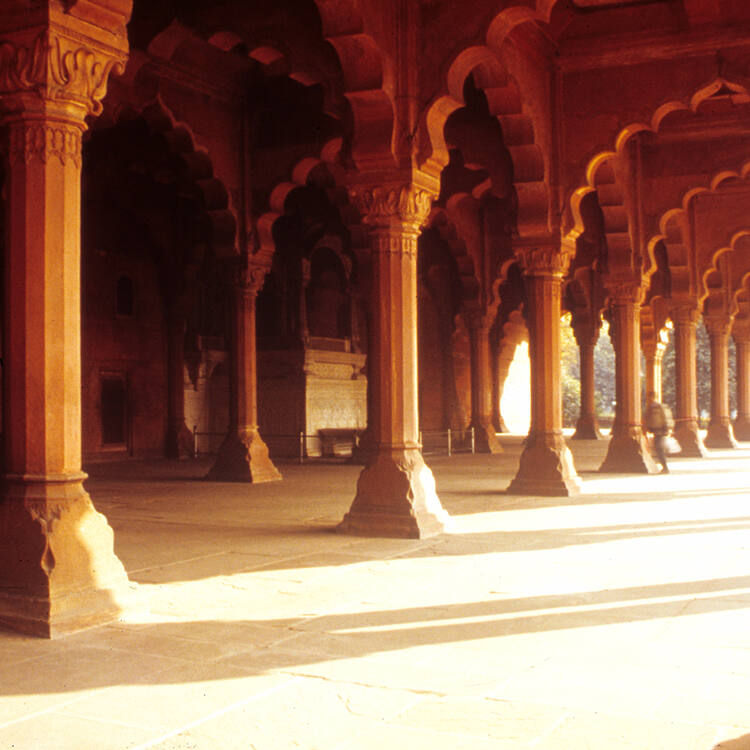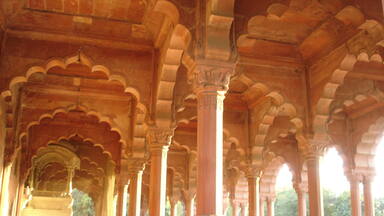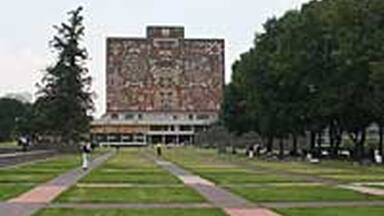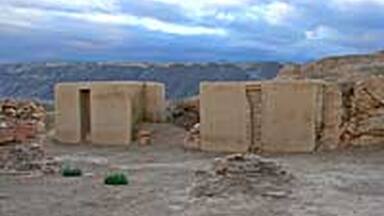Red Fort Complex
Red Fort Complex
The Red Fort Complex was built as the palace fort of Shahjahanabad – the new capital of the fifth Mughal Emperor of India, Shah Jahan. Named for its massive enclosing walls of red sandstone, it is adjacent to an older fort, the Salimgarh, built by Islam Shah Suri in 1546, with which it forms the Red Fort Complex. The private apartments consist of a row of pavilions connected by a continuous water channel, known as the Nahr-i-Behisht (Stream of Paradise). The Red Fort is considered to represent the zenith of Mughal creativity which, under the Shah Jahan, was brought to a new level of refinement. The planning of the palace is based on Islamic prototypes, but each pavilion reveals architectural elements typical of Mughal building, reflecting a fusion of Persian, Timurid and Hindu traditions The Red Fort’s innovative planning and architectural style, including the garden design, strongly influenced later buildings and gardens in Rajasthan, Delhi, Agra and further afield.
Description is available under license CC-BY-SA IGO 3.0
Ensemble du Fort Rouge
Palais-fort de Shahjahanabad – la nouvelle capitale de Shah Jahan (1628-1658), 5e empereur moghol d’Inde –, le Fort Rouge doit son nom à ses murs d’enceinte imposants en grès rouge. Il est voisin d’un autre fort, le fort Salimgarh, construit par Islam Shah Suri en 1546. À eux deux, ils forment l’ensemble du Fort Rouge. Les appartements privés consistent en une rangée de pavillons reliés par un canal que l’on appelle le Nahr-i-Bihisht, ou Fleuve du Paradis. On considère que le Fort Rouge représente l’apogée de la créativité moghole qui, sous l’empereur Shah Jahan, atteint un nouveau degré de raffinement. La disposition du palais est d’inspiration islamique, mais chaque pavillon dévoile des éléments architecturaux typiques des bâtiments moghols, reflétant une fusion des traditions perses, timourides et hindoues. La conception novatrice et le style architectural du Fort Rouge, notamment l’aménagement de ses jardins, ont fortement influencé les constructions et les jardins ultérieurs au Rajasthan, à Delhi, à Agra et dans les régions avoisinantes.
Description is available under license CC-BY-SA IGO 3.0
مجمَّع الحصن الأحمر، دلهي
بني الموقع قصراً محصناً لمدينة شاه جاهان آباد، المدينة الجديدة للامبراطور المغولي الخامس في الهند، شاه جاهان (1628 – 58). استمد الحصن الأحمر تسميته من جدرانه الضخمة المحتوية على حجر رملي أحمر. وهو متاخم لحصن أقدم بناه إسلام شاه سور عام 1546، ويشكل الموقعان ما يُعرف بمجمَّع الحصن الأحمر. بنيت الشقق السكنية الخاصة في صف من الأجنحة التي تربط بينها قناة مائية تدعى "ساقية الجنّة". تصميم القصر مستمد من الوصف الوارد للجنة في القرآن. وداخل القصر كُتب هذان البيتان الشعريان: "إذا كان من جنة على الأرض، فإنها هنا، فإنها هنا". يمثل الحصن الأحمر ذروة الإبداع المغولي الذي بلغ في عهد الامبراطور شاه جاهان مستوى جديداً من التفنن. يقوم تصميم القصر على الهندسة الإسلامية، لكن كل جناح يكشف عناصر هندسية مميزة للبناء المغولي، ويعكس التقاليد الفارسية والتيموريدية والهندوسية. وقد ترك التصميم المبتكَر والأسلوب المعماري للحصن الأحمر، بما فيه تصميم الحدائق، تأثيراً كبيراً على الأبنية والحدائق التي أقيمت لاحقاً في راجستان ودلهي وأغرا وغيرها. وما يزيد من أهمية هذا الصرح الأحداث التي وقعت فيه. فالمجمَّع يعكس من خلال بنيانه وأسسه جميع مراحل التاريخ الهندي منذ الحقبة المغولية حتى الاستقلال.
فردوس وجحيم شاه جاهان رسالة اليونسكو (2007)
source: UNESCO/CPE
Description is available under license CC-BY-SA IGO 3.0
德里红堡群
德里红堡建筑群是建在印度莫卧儿王朝第五代国王沙贾汉(1628-1658年)的新首府——沙赫杰汗纳巴德的宫殿。因其大规模的红色砂岩围墙而得名。红堡毗邻1546年Islam Shah Sur建造的萨林加尔古堡,两者共同构成了红堡建筑群。私人寓所由一排亭子构成,亭子之间靠连续的水渠连接,这些水渠称作Nahr-i-Behisht,或“天堂水流”。宫殿的设计模仿了《古兰经》对于天堂的描述,殿内刻有这样一句话:“如果人间有天堂,那么天堂就在这里,不在别处。”人们把红堡看作莫卧儿王朝创造力达到顶峰的典范,在沙贾汉国王的带领下,其设计登上了新的高度。宫殿的规划以伊斯兰原型为依据,而每座亭子展现了具有莫卧儿王朝典型建筑特征的元素,反映出波斯、贴木儿王朝和印度建筑传统的相互融合。红堡的创新性规划和建筑风格,及其花园设计,对于后来拉贾斯坦、德里、阿格拉和其他地方的建筑及花园产生了极大的影响。历史事件的价值进一步强化了建筑本身的重要性。红堡建筑群通过其建筑反映了印度从莫卧儿王朝时期到印度独立之间各个阶段的历史发展。
source: UNESCO/CPE
Description is available under license CC-BY-SA IGO 3.0
Комплекс «Красный форт»
Дворец-крепость Шахджаханабад - новая столица Шах-Джахана (1628-1658), 5-го императора династии Моголов. Своим именем - "Красный форт" - он обязан красному песчаннику, из которого выстроены его мощные крепостные стены. Он выстроен по соседству с крепостью Салимгарх, которая была сооружена Исламом Шахом Сури в 1546 году. Вместе они составляют ансамбль "Красного форта". Жилые аппартаменты представляют собой череду дворцов, связанных каналом, который называют Нахр-и-Бихишт, или Райской рекой. "Красный форт" считают вершиной строительного творчества моголов, империя которых достигла расцвета при Шах-Джахане. Планировка дворца несет следы исламского влияния, но каждое из строений украшено типично могольскими элементами архитектуры - смесью персидских, тимуридских и индуских традиций. Новаторский для той эпохи архитектурный стиль "Красного форта", особенно его внутреннее убранство и сады, оказали заметное влияние на строительство и парковую архитектуру более поздних построек в Раджастане, Дели, Агре и соседних районах.
source: UNESCO/CPE
Description is available under license CC-BY-SA IGO 3.0
Conjunto del Fuerte Rojo
El Fuerte Rojo fue el palacio fortificado de Shahjahanabad, la nueva capital del quinto emperador mogol de la India, Shah Jahan (1628-1658). Su nombre se debe al color rojo de la piedra arenisca con que se construyeron sus espesas murallas. En sus proximidades se alza otra fortaleza más antigua, Salimgarh, que fue edificada por Islam Shah Suri en 1546. Los dos edificios forman el Conjunto del Fuerte Rojo. Los aposentos privados consisten en una serie de pabellones dispuestos en hilera y unidos por un canal conocido por el nombre de Nahr-i-Bihisht, Arroyo del Paraíso. Se considera que el Fuerte Rojo es una muestra representativa del apogeo de la creatividad del arte mogol, que en tiempos del emperador Shah Jahan alcanzó un mayor grado de refinamiento. La planta del palacio se basa en prototipos islámicos, pero cada uno de los pabellones muestra elementos arquitectónicos típicos de los edificios mogoles, en los que se puede observar la fusión de las tradiciones persas, timures e hindúes. La planificación y el estilo arquitectónico innovadores del Fuerte Rojo, así como el diseño de sus jardines, ejercieron una influencia considerable en la concepción de edificios y jardines realizados ulteriormente en el Rajastán, Delhi, Agra y otros lugares.
source: UNESCO/CPE
Description is available under license CC-BY-SA IGO 3.0
レッド・フォートの建造物群
レッド・フォートの建造物群は、17世紀中頃にムガル帝国5代皇帝シャー・ジャハーンが、首都をアーグラからデリーに移した際に建造した居城。建材に赤砂岩が使用されていることが名前の由来で、隣接する1546年建造のサリンガル城砦も、世界遺産に含まれる。レッド・フォートは「コーラン」に描写された楽園を模して建てられた城で、イスラム建築を基本としながら、ペルシアやティムール、ヒンドゥーなどの影響を受けたムガル様式が随所に見られる。八角形プランの採用など、レッド・フォートの革新的な設計は、後のラジャスターン、デリー、アーグラなどの建築物や庭園建設に大きな影響を及ぼした。source: NFUAJ
Rode Fort complex
Het Rode Fort complex bestaat uit het Rode Fort (1638) en het aangrenzende fort Salimgarth (1546). Het fort werd gebouwd als paleisfort voor Shahjahanabad, de nieuwe hoofdstad van de vijfde Mogol keizer van India. Het fort dankt zijn naam aan de massieve muren van rode zandsteen en wordt beschouwd als hoogtepunt van Mogol creativiteit en architectuur. Kenmerkend hiervoor zijn de paviljoenen en het waterkanaal Nahr-i-Behisht – stroom van het paradijs – dat de paviljoenen verbindt. Het Rode Fort heeft een groot stempel gedrukt op de architectuur van latere gebouwen en tuinen vanwege de vernieuwende manier waarop er gepland en gebouwd werd.
Source: unesco.nl
लाल किला परिसर
भारत के 5वें मुगल सम्राट शाहजहाँ ने लाल किला परिसर का निर्माण नई राजधानी शाहजहाँबाद के गढ़ के रूप में किया था। 1546 में इस्लाम शाह सूरी द्वारा बनाए गए सलीमगढ़ के एक पुराने किले के पास विशाल लाल बलुआ पत्थर की दीवारों की वजह से इसे लाल किला परिसर कहा जाता है। निजी कमरे मंडपों की पंक्ति से बने हैं, जो नहर-ए-बहिश्त (स्वर्ग की धारा) नाम की निरंतर जल धारा से जुड़े हुए हैं। माना जाता है कि लाल किला मुगल रचनात्मकता की पराकाष्ठा है, जिसे शाहजहाँ की निगरानी में परिष्कृत कर एक नए स्तर का बनाया गया था। महल का निर्माण इस्लामिक आदर्श पर आधारित है, लेकिन प्रत्येक मंडप फारसी, तैमूरी तथा हिन्दू परंपरा के मेल को दर्शाते हुए मुगल वास्तुशिल्प निर्माण शैली का नमूना प्रस्तुत करते हैं। लाल किले के बाग की बनावट सहित इसकी नवीन योजना और वास्तुकला शैली ने बाद में राजस्थान, दिल्ली, आगरा के साथ ही अन्य क्षेत्रों के बागों और इमारतों पर बड़ा प्रभाव डाला है।
Source: India
Outstanding Universal Value
The planning and design of the Red Fort represents a culmination of architectural development initiated in 1526 AD by the first Mughal Emperor and brought to a splendid refinement by Shah Jahan with a fusion of traditions: Islamic, Persian, Timurid and Hindu. The innovative planning arrangements and architectural style of building components as well as garden design developed in the Red Fort strongly influenced later buildings and gardens in Rajasthan, Delhi, Agra and further afield. The Red Fort has been the setting for events which have had a critical impact on its geo-cultural region.
Criterion (ii): The final flourishing of Mughal architecture built upon local traditions but enlivened them with imported ideas, techniques, craftsmanship and designs to provide a fusion of Islamic, Persian, Timurid and Hindu traditions. The Red Fort demonstrates the outstanding results this achieved in planning and architecture.
Criterion (iii): The innovative planning arrangements and architectural style of building components and garden design developed in the Red Fort strongly influenced later buildings and gardens in Rajasthan, Delhi, Agra and further afield. The Red Fort Complex also reflects the phase of British military occupation, introducing new buildings and functions over the earlier Mughal structures.
Criterion (vi): The Red Fort has been a symbol of power since the reign of Shah Jahan, has witnessed the change in Indian history to British rule, and was the place where Indian independence was first celebrated, and is still celebrated today. The Red Fort Complex has thus been the setting of events critical to the shaping of regional identity, and which have had a wide impact on the geo-cultural region.
The Red Fort Complex is a layered expression of both Mughal architecture and planning, and the later British military use of the forts. The most dramatic impacts on the integrity of the Red Fort Complex come from the change of the river into a major road, which alters the relationship of the property to its intended setting; and from the division of the Salimgarh Fort by a railway. Nevertheless the Salimgarh Fort is inextricably linked to the Red Fort in use and later history. The integrity of the Salimgarh Fort can only be seen in terms of its value as part of the overall Red Fort Complex. The authenticity of the Mughal and British buildings in the Red Fort Complex is established, although more work is needed to establish the veracity of the current garden layout. In the specific case of the Salimgarh Fort, the authenticity of the Mughal period is related to knowledge of its use and associations, and of the built structures dating from the British period.
The nominated property has been declared a monument of national importance under the Ancient Monument and Archaeological Sites and Remains Act, 1959. A buffer zone has been established. Although the state of conservation of the property has improved over the past ten years, much more work is needed to put the overall state of the property into a stable condition and to ensure visitors do not contribute to its decay. The Red Fort Complex is managed directly by the Archaeological Survey of India, which is also responsible for the protection of all national level heritage sites in India and Indian cultural properties included in the World Heritage List.

 View photos from OUR PLACE the World Heritage collection
View photos from OUR PLACE the World Heritage collection


